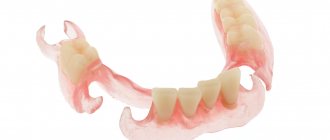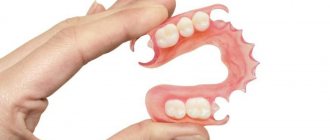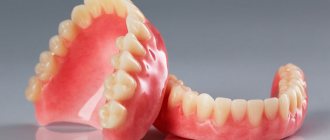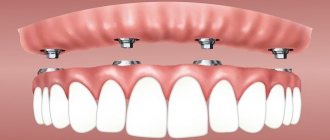August 7, 2019
Some people identify or confuse silicone dentures with nylon, clasp, and even acrylic. However, you need to understand that we are talking about different designs, which, although they are intended to restore lost teeth, differ in their characteristics and even in their service life. Journalists from the UltraSmile.ru portal will tell their readers about the features of silicone removable products, because for some they can be decisive in choosing the type of dental prosthetics.
Dentures are very flexible, but at the same time durable
Silicone prostheses, or rather their base and fixing elements, are made of silicone, which is characterized by increased flexibility, elasticity and a certain degree of softness, which is why they are often compared or even confused with nylon. However, they are so durable and even somewhat rigid that for this reason they are confused with acrylic. But despite a number of positive similarities with the listed types of removable systems, silicone structures are partially free of their disadvantages. For example, unlike nylon ones, they do not deform under mechanical stress and distribute the chewing load more evenly. And unlike acrylic ones, they do not rub the mucous membrane and injure the soft tissues of the oral cavity to a lesser extent, and the process of getting used to them is faster.
Such prostheses are quite flexible and durable.
You need to understand that in nylon prostheses the base is made of nylon, in acrylic ones - from acrylic, and in silicone ones - from silicone, respectively. As for their comparison with clasp systems, silicone models also include fixing hooks or clasps, but again they are made not of metal, but of transparent silicone. In addition, silicone devices, despite their good strength, are unable to splint teeth loosened as a result of the development of periodontal tissue diseases.
Independent researchers have found that the material the base of the prosthesis is made of has a significant impact on the functionality of the structure and the level of comfort felt by the patient. The adverse effects of the base material (for example, acrylic) can be reduced by creating a two-layer base1, and in this regard, one of the most promising is silicone, which does not injure the mucous membrane and is non-toxic. Those. In the future, silicone can be combined with other materials to enhance the positive qualities of the prosthesis.
Which dentures are better – nylon or acrylic?
Both types differ in competitive advantages and disadvantages, and also differ in price.
For example, acrylic solutions are made from durable acrylic plastic, can be made in a few hours, and can be installed the same day. The design weighs little, does not require special care, and most importantly, it is inexpensive. In most cases, older people are given acrylic dentures, which organically combine quality and price.
Among the disadvantages of acrylic, we note the release of methacrylate, which can be negatively tolerated by the body. Also, during wearing, adjacent teeth are subject to abrasion, which can lead to the development of caries.
Nylon analogues are more expensive, but also more aesthetically pleasing. These elastic designs are distinguished by the presence of a soft nylon base, which is practically invisible in the mouth. Prostheses made of nylon do not cause an allergic reaction and are comfortable to wear.
The disadvantages of nylon teeth are the fragility and softness of the material, which is not always able to withstand the chewing load. Over time, the denture “sags,” which can injure the gums. That is why, when wearing such structures, you should carefully monitor your oral cavity and regularly visit the dentist.
The designs are distinguished by increased aesthetics
When using silicone prosthetics, the restoration looks very natural, and all this is thanks to two qualities of such a material as silicone:
- the material tends to adapt to the natural color of the soft tissues of the gums, it literally merges with them,
- the material fits very tightly to the mucous membrane and is well fixed in the oral cavity: due to its high elasticity, the silicone prosthesis can be tightly adjusted to the gums, taking into account all the individual anatomical features of the patient.
The material tends to adapt to the natural color of the gums.
If the structures are created by a professional orthopedist and dental technician, then at first they will look perfect - and the appearance can be preserved with high-quality care.
Dentures are not suitable for restoring all teeth
Silicone dentures are ideal for restoring teeth located in the smile area. Most often they help solve the problem of the absence of one or more teeth; less often they are used to fill multiple defects. Those. Partial or single structures are created on a silicone basis, but they are rarely made complete, because in case of complete edentia, their use is inappropriate. Why? They will not be able to cope with the chewing load. Reviews from some patients indicate that when they try to chew food in such orthopedic devices, they experience pain and even mobility of the structure.
Silicone dentures are contraindicated for installation as a permanent structure in the complete absence of teeth in the mouth, in the presence of acute atrophy of the jaw bone and alveolar ridge.
Kinds
Prosthetics are carried out using three types of structures:
- A complete denture is placed to restore the upper or lower row when all teeth are missing. But the fixation of the product is insufficient, so the method is used if treatment by other methods is impossible for various reasons.
- A private one is placed to recreate two or three neighboring units. A clasp fastening is used for fixation.
- A single denture is placed to restore one tooth. Fixation is carried out with side clasps to adjacent supports.
The structures are only suitable as a temporary solution to the problem.
Silicone dentures do not injure or rub the oral mucosa and look good, but reviews from professional orthopedists indicate that they are most often used only as a temporary measure. For example, until the patient receives a permanent prosthesis or in preparation for dental implantation. The maximum that can be worn comfortably is 12-18 months, i.e. about a year and a half. Then they need to be replaced.
Silicone material has several significant disadvantages that force restrictions on its service life:
- the product requires complex care: silicone looks beautiful and is not susceptible to pigmentation from food and drinks, despite this it is difficult to polish and thoroughly clean, so over time bacterial plaque accumulates on it, which can become a source of new dental problems (gum inflammation , caries, tooth decay). In addition, when pathogenic microflora predominates, the mouth begins to smell bad,
- If a large number of teeth are restored with a prosthesis, then it needs frequent adjustments: otherwise it will not be able to withstand chewing loads for long and will often become deformed.
The silicone base of removable dentures may lose its attractiveness if you clean them with hard hygiene items and pastes containing even a minimal amount of abrasives. Therefore, to preserve its shape, you need to use only a brush with soft bristles and baby toothpaste (some Internet users advise using soap, but this is still not worth doing).
Advantages and disadvantages
Advantages of silicone structures:
- simple fastening;
- no staining or deformation;
- there is no pressure on the gum tissue;
- high aesthetics;
- no turning of support units is carried out;
- easy care;
- Removing and installing the structure is easy.
Disadvantages include:
- tissue injury when chewing;
- plaque quickly accumulates on the surface;
- sagging of fabrics during prolonged wear;
- the price is higher than for other types of structures.
Manufacturing stages and installation
The following steps are used to install silicone dentures:
- the dentist conducts an initial examination and prescribes tests;
- preparation is carried out, including office cleaning, treatment of caries or other diseases (if necessary);
- an impression is made, a plaster model is made in the laboratory;
- the silicone mass is processed at high temperature, a structure is produced on its basis, which is ground and polished;
- During fitting, correction is possible; if everything is in order, the prosthesis is put in place, and the patient is given recommendations on hygiene.
Care and service life
To care for removable dental dentures, you should follow the following hygiene rules:
- daily brushing, rinsing the mouth after every meal;
- use of soft brushes, special brushes and irrigators, rinses and non-abrasive pastes for care;
- To completely remove food particles, the denture is removed, it must be washed using the means intended for this;
- It is recommended to store the product in a container; if cracks or other damage is detected, you should immediately consult a doctor.
You should also visit the dentist regularly for preventive examinations. All diseases are treated in a timely manner, which allows maintaining the integrity of the structure and oral health. Typically, service life is five years or more. But everything depends on compliance with the rules of care and timely treatment.
Price
To find out the cost of removable dentures, you need to visit the clinic and undergo an initial examination. This is necessary to assess the condition of the oral cavity, select a design, materials and determine a treatment strategy. The price will depend on the following nuances:
- patient's oral health;
- diagnostic methods (radiography, assessment of the condition of bone tissue, general tests may additionally be required);
- diseases of the teeth and gums that must be treated before prosthetics;
- the number of missing teeth, the location of such areas;
- materials and types of selected design for prosthetics;
- complexity of manufacturing;
- type of fastening on the jaw.
The price can be announced in advance only for a certain type of structure and materials, one restored unit or a complete prosthesis. But it will not take into account pre-treatment preparation, diagnostic tests and other activities. The average cost is 30 thousand rubles.
About our clinic
Magenta Dental Clinic is a modern dental clinic that provides patients with the following benefits:
- treatment in accordance with accepted international standards;
- guaranteed functional and aesthetic results;
- qualified personnel;
- use of proven equipment and materials certified in the Russian Federation and Europe;
- double control of the quality of therapy and achieved results;
- different types of instrumental and hardware examinations;
- comfortable conditions and affordable prices.
To make an appointment with a doctor, leave a request on the website or call. We will advise you on treatment issues or prices for services provided, and make an appointment with the clinic’s specialists at a convenient time.
Comparison of silicone structures with other types of removable dentures
To understand how silicone models differ from others, those with which they are confused or compared, see the summary table.
| Silicone | Acrylic | Nylon | Clasp | |
| What are they made of? | Base and hooks – silicone, teeth – plastic | Base – acrylic, teeth – plastic | Base – nylon, teeth – plastic | The base has a metal arch, the base is acrylic, the teeth are plastic, the hooks are metal |
| Fixation method | Hooks to abutment teeth | With hooks or by sucking on the mucous membrane | With hooks or by sucking on the mucous membrane | Hooks, locks, telescopic crowns |
| How many teeth are restored? | Used for partial or multiple edentia | Any quantity | Any quantity | Suitable only for partially edentulous patients |
| Possibility of developing allergies | Absent | High enough | Small | Quite high (for metals) |
| Lifetime | 1-1.5 years | 3-5 years | 2-4 years | 5-7 years |
| Price | From 20,000 rubles | From 15,000 rubles | From 20,000 rubles | From 35,000 rubles |
Silicone dentures are liked by most patients who have them installed, so reviews about them are mostly positive. The only thing that upsets patients is the prices for them, because they are quite high, especially considering the fact that the service life is short and the designs are only good as a temporary measure. How much do they cost? The cost starts from 20,000 rubles, but it can increase depending on the number of teeth being restored.
Notice
: Undefined variable: post_id in
/home/c/ch75405/public_html/wp-content/themes/UltraSmile/single-item.php
on line
45 Notice
: Undefined variable: full in
/home/c/ch75405/public_html/wp-content /themes/UltraSmile/single-item.php
on line
46
Rate this article:
( 3 ratings, average: 5.00 out of 5)
prosthetics
- Lebedenko I.Yu., Voronov A.P., Voronov I.A., Nasuev G.M. Studies of the sanitary-chemical and toxicological properties of the domestic silicone material of cold polymerization “Silast-M” for removable dentures. Saratov scientific and medical journal, 2014.
Expert “Silicone devices are fixed to the remaining teeth in the mouth using hooks, also made of base material. These hooks are quite soft, but over time they begin to injure the gum in the neck of the supporting tooth and lead to its exposure - this provokes the development of an inflammatory process and severe pain. In addition, silicone clasps are unable to evenly distribute the chewing load; they excessively load the supporting teeth, while the prosthesis itself puts pressure on the soft tissues of the prosthetic bed, which accelerates atrophic processes in the bone tissue of the jaw.” Orthopedic dentist Sambuev Bair Sergeevich
Consulting specialist
Sambuev Bair Sergeevich
Specialization: Orthopedic dentist Experience: 10 years
Indications and contraindications for installation
The use of silicone removable dentures is indicated in certain cases. These include:
- completely or partially missing teeth;
- allergic reaction to acrylic structures;
- heavy or extreme sports;
- cardiovascular diseases and pancreatic diseases;
- restoration of a lost baby tooth ahead of time to avoid the occurrence of malocclusion.
There are also contraindications to the installation of flexible prostheses. They are as follows:
- periodontal disease;
- gum disease;
- atrophy of the jaw bone.
Flexible structures are manufactured in several stages. Prosthetics of silicone teeth are carried out in the following order:
- The teeth are prepared for installation. They are treated and the stone and plaque are removed without fail.
- A cast is taken of the jaw and a plaster model is made.
- The prosthesis is made according to the shape of the model, polished and prepared for fitting.
- They try it on the patient and correct any defects. If necessary, modifications are made.
Comments
Tell me, do I need to grind my teeth to install silicone dentures? I am looking for a temporary version of the prosthesis, because... I’m missing one tooth and I still can’t decide what’s better to put in next – a bridge or an implant.
Oleg (08/09/2019 at 17:28) Reply to comment
- Dear Oleg! To install silicone dentures, you do not need to grind down the supporting teeth; soft silicone hooks will simply tightly grasp them and hold the structure in the mouth. If you are still deciding which type of permanent prosthetics to choose, then silicone temporary removable devices are what is right for you. As for what is better to install later - an implant or a bridge - we will give you advice: in terms of price, both of these solutions today will be approximately equal, but in terms of quality and durability, implantation wins. The fact is that when installing a bridge, you will have to grind down two supporting teeth and depulpate them; they will bear a colossal load, which will lead to their rapid destruction. The big disadvantage of the bridge is that after removal the patient has to restore not 1, but 2-3 teeth. The implant works independently, without having a destructive effect on neighboring units, and if it is installed well, it will last a lifetime.
Editorial staff of the portal UltraSmile.ru (08/12/2019 at 10:13 am) Reply to comment
Write your comment Cancel reply
Production and installation
Models made of flexible materials are manufactured in several stages. First you need to carry out dental treatment, if necessary. These could be events:
- treatment of caries;
- removal of dental plaque;
- whitening;
- filling.
To make a model of the jaw, impressions are taken of the teeth and made using a special plastic mass. In laboratory conditions, they are filled with plaster and wait until it hardens. The result is a model with the outlines of teeth. Then the models themselves are made from flexible material, according to the layout.
Many patients are advised to find out whether other dental prosthetic options are possible before installation. This is due to the fact that wearing structures brings a certain discomfort to many. The product is secured with clasps, they are fixed to the supporting teeth, and if they are missing, then implants need to be implanted, which act as supporting elements.










